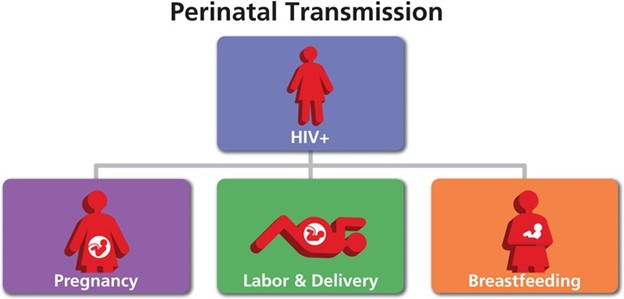Human immunodeficiency virus (HIV) may be perinatally transmitted:
Only in the third trimester from the maternal circulation.
By a needlestick injury at birth from unsterile instruments.
Only through the ingestion of amniotic fluid.
Through the ingestion of breast milk from an infected mother.
The Correct Answer is D
The correct answer is choice D. Perinatal transmission of HIV is when HIV is passed from a woman with HIV to her child during pregnancy, childbirth, or breastfeeding.

Breast milk from an infected mother can contain HIV and infect the baby.
Choice A is wrong because HIV can be transmitted at any stage of pregnancy, not only in the third trimester.
Choice B is wrong because needlestick injury is not a common mode of perinatal transmission of HIV. It is more likely to occur among health care workers who are exposed to contaminated needles or sharp objects.
Choice C is wrong because HIV can also be transmitted through the ingestion of amniotic fluid, but it is not the only way. Amniotic fluid is the fluid that surrounds and protects the baby in the womb.
Nursing Test Bank
Naxlex Comprehensive Predictor Exams
Related Questions
Correct Answer is B
Explanation
A way to establish rapport. Doing a simple magic trick using gauze is a way to gain the child’s trust and attention, and to make the dressing change less stressful and more fun. This is appropriate for a 5-year-old child who is in the stage of initiative versus guilt according to Erikson’s theory of psychosocial development.
Choice A is wrong because 5-year-old children are curious and imaginative, and they enjoy magic tricks and fantasy play.
Choice C is wrong because a simple magic trick is not too distracting, but rather a way to engage the child and reduce anxiety.
Choice D is wrong because a simple magic trick is not inappropriate due to the child’s cognitive development. According to Piaget’s theory of cognitive development, 5-year-old children are in the preoperational stage, which means they can use symbols and language to represent objects and events.
A magic trick using gauze is a symbolic representation of something else, which the child can understand and appreciate.
Correct Answer is C
Explanation
This is because self-monitoring of blood glucose allows children to learn how their blood sugar levels change in response to different factors such as food, exercise, stress, and medication.
It also helps them to adjust their insulin doses and dietary intake accordingly. Self-monitoring of blood glucose can improve glycemic control and reduce the risk of complications.
Choice A is wrong because it is not a less expensive method of testing.
Self-monitoring of blood glucose requires a glucose meter, test strips, lancets, and a logbook, which can be costly for some families.
Choice B is wrong because it is not less accurate than laboratory testing.
Self-monitoring of blood glucose can provide accurate and reliable results if done correctly and regularly.
Laboratory testing is usually done periodically to measure the average blood sugar level over the past 2 to 3 months (hemoglobin A1c).
Choice D is wrong because it implies that the parents are not involved in the child’s diabetes management.
Parents should still provide support and guidance to their children with diabetes, especially when they are young or newly diagnosed. Parents should also monitor their child’s blood glucose levels and help them with insulin administration if needed.
Whether you are a student looking to ace your exams or a practicing nurse seeking to enhance your expertise , our nursing education contents will empower you with the confidence and competence to make a difference in the lives of patients and become a respected leader in the healthcare field.
Visit Naxlex, invest in your future and unlock endless possibilities with our unparalleled nursing education contents today
Report Wrong Answer on the Current Question
Do you disagree with the answer? If yes, what is your expected answer? Explain.
Kindly be descriptive with the issue you are facing.
